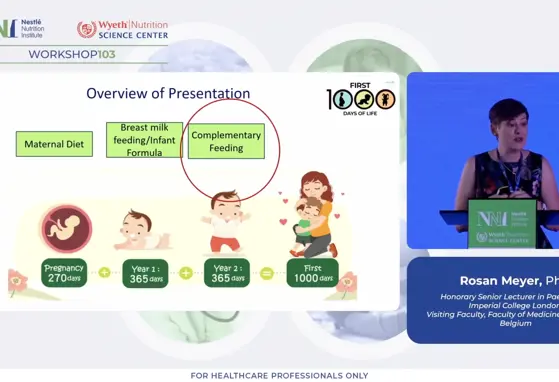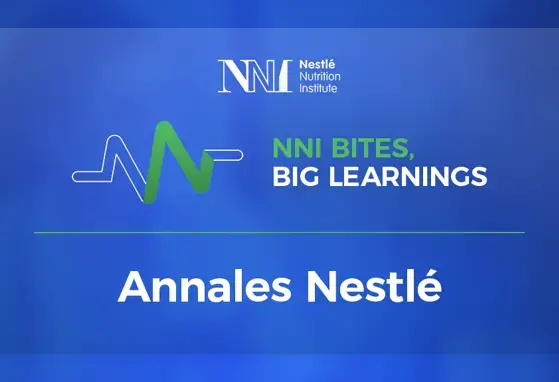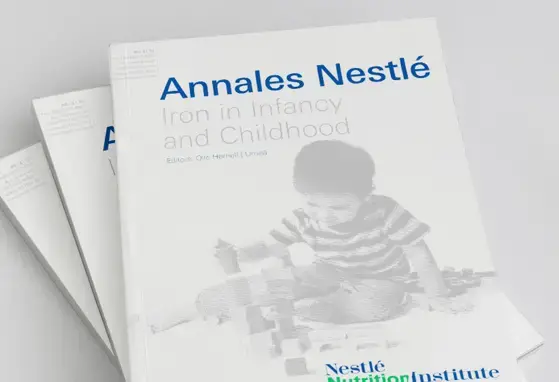20 Years On, the GINI Study Still Serves Fresh Insights
We have come very far in managing allergies, even reactions to cow’s milk. But where did it all begin? In this article, we will learn about the GINI Study and how it changed the way doctors and parents manage children with allergies.
Over 10 years ago, food allergies were described as the “second wave” of the allergy epidemic, rising slowly behind the “first wave” of respiratory allergies (allergic rhinitis & asthma). One concern was that those affected by this second wave seemed less likely to outgrow their allergies, resulting in long-term disease burden.1
Fast forward to the present, allergic disease is still increasing and primary prevention remains top of mind as management. In the 1990s, studies looked at the role of partially and extensively hydrolyzed infant formulas in reducing the risk of atopic disease in at-risk infants.2 The premise was that smaller peptides could induce oral tolerance without resulting in sensitization. The low molecular weight was associated with decreased allergenicity of the protein, and this caused a possible decrease in the development of allergies.3
Among the different studies done, none stood out as much as the German Infant Nutritional Intervention (GINI) Study, which came out with its initial results in 2003.4 To date, it remains the most extensive study on allergy prevention using hydrolyzed formulas, and it has the longest follow-up period of up to 20 years.5
The GINI study evaluated the preventive effects of different hydrolyzed formulas and compared them with intact cow's milk formula (CMF) based on allergic manifestations in healthy, high-risk newborns. A total of 2,252 infants at risk for atopy were randomized at birth during their first 4 months of life to receive one of four blinded formulas: a partially hydrolyzed whey formula (pHF-W), an extensively hydrolyzed whey formula (eHF-W), an extensively hydrolyzed casein formula (eHF-C), and CMF. The primary outcome was the presence of allergic manifestations (atopic dermatitis [AD], urticaria, gastrointestinal manifestations of food allergy, or any combination of these) at 1 year of age.6
Figure 1. Subject profile of the GINI study 4
Results at 1 year confirmed that allergy prevention in high-risk infants was possible with hydrolyzed formulas instead of a standard infant formula.5 Allergic manifestations were significantly prevented by eHF-C, and atopic dermatitis was prevented by both eHF-C and pHF-W.6
Upon 3- and 6- year follow-ups, results supported a significant risk reduction of atopic dermatitis for eHF-C and pHF-W compared to that for CMF.7-8 This effect was sustained until 15 years, during which the preventive effect was not just for cutaneous allergies but now for respiratory allergies (allergic rhinitis) as well.9
Figure 2. The GINI study through the years 4, 5-9
Despite these promising results, controversies later arose,10 with meta-analyses stating “no consistent evidence to support the use of hydrolyzed formulas in allergy prevention.11,12 However, it is important to note that not all hydrolyzed formulas provide a similar degree of protection. Various factors, such as the protein source, method of hydrolysis, and degree of hydrolysis, are dependent on the manufacturer and result in differences among formulas. Thus, efficacy and safety should be studied for each formula separately.13
The 2020 GINI study showed both eHF-C and pHF-W having a sustained preventive effect on the period prevalence of atopic dermatitis.4 The preventive effect of eHF-C was seen in all visits in the intention-to-treat (ITT) and per-protocol analysis (PP) groups, whereas the preventive effect of pHF-W was more evident in the PP group. Moreover, the effects of eHF-C and pHF-W were seen in the cumulative incidence of eczema from 0–20 years, with a 27% risk reduction (RR) for pHF-W (RR: 0.73; 95% CI, 0.57–0.94) and 39% for eHF-C (RR: 0.61; 95% CI, 0.47–0.78) compared to those for CMF (Figure 1).4
Figure 3: German Infant Nutritional Intervention 20-year follow-up: effect of infant formula on eczema.4,5
*Significant effect.
†Strong effect with loss of significance.
‡Adjusted for parental history of disease, heredity of family allergy, sex, study region, education and cigarette smoking of young adult, actual pets, and type of questionnaire.
aOR: adjusted odds ratio; CI: confidence interval; CMF: cow’s milk based formula; eHF-C: extensively hydrolyzed casein formula; eHF-W: extensively hydrolyzed whey formula; ITT: intention-to-treat; OR: odds ratio; pHF-W: partially hydrolyzed whey formula; RR: relative risk.
The 20-year results showed a significantly lower period prevalence of asthma in infants who received either pHF-W or eHF-C compared with those who received CMF when data for both genders were combined. Odds ratios for the prevalence of asthma between 16 to 20 years old (n=1,184) were 0.47 (95% CI, 0.25–0.89) and 0.50 (95% CI, 0.27–0.95) for the pHF-W and eHF-C groups, respectively (Figure 2).4
Figure 4: German Infant Nutritional Intervention 20-year follow-up: effect of infant formula on asthma.4,5
*Significant effect.
†Adjusted for parental history of disease, heredity of family allergy, sex, study region, education and cigarette smoking of young adult, actual pets, and type of questionnaire.
aOR: adjusted odds ratio; CI: confidence interval; CMF: cow’s milk based formula; eHF-C: extensively hydrolyzed casein formula; eHF-W: extensively hydrolyzed whey formula; ITT: intention to treat; OR: odds ratio; pHF-W: partially hydrolyzed whey formula; RR: relative risk.
The latest GINI results highlight that both eHF-C and pHF-W confer substantial and continuous reduction of AD/eczema from 3 to 20 years. Moreover, significant decrease of risk by more than 50% was observed from eHF-C and pHF-W, and this was not observed in eHF-W.4
These data establish that early nutritional interventions with a hydrolyzed formula that has proven efficacy may be recommended for at-risk infants if exclusive breastfeeding is not possible. Furthermore, the preventive effect is seen in adulthood for both eczema and allergic asthma. Even with the conflicting findings from meta-analyses or systematic reviews, the GINI study continues to give insights into the life-course epidemiology of allergic disease and contributes to knowledge on nutritional interventions in the prevention of allergic disease.5
REFERENCES:
1. Prescott S, Allen KJ. Food allergy: Riding the second wave of the allergy epidemic. Pediatr Allergy Immunol. 2011; 22: 155–160.
2. Fleischer DM, et al. Hydrolyzed Formula for Every Infant? Nestle Nutr Inst Workshop Ser. 2016;86:51-65.
3. Cabana MD. The Role of Hydrolyzed Formula in Allergy Prevention. Ann Nutr Metab. 2017;70(suppl 2):38-45.
4. Gappa M, et al. Long-term effects of hydrolyzed formulae on atopic diseases in the GINI study. Allergy. 2020;00:1–5.
5. Gappa M, et al. EMJ Allergy Immunol. 2021; 6[Suppl 1]:2-5.
6. von Berg A, et al. The effect of hydrolyzed cow's milk formula for allergy prevention in the first year of life: the German Infant Nutritional Intervention Study, a randomized double-blind trial. J Allergy Clin Immunol. 2003 Mar;111(3):533-40.
7. von Berg A, et al. Certain hydrolyzed formulas reduce the incidence of atopic dermatitis but not that of asthma: three-year results of the German Infant Nutritional Intervention Study. J Allergy Clin Immunol. 2007 Mar;119(3):718-25. Epub 2007 Jan 22.
8. von Berg A, et al. Preventive effect of hydrolyzed infant formulas persists until age 6 years: long-term results from the German Infant Nutritional Intervention Study (GINI). J Allergy Clin Immunol. 2008; 121: 1442–1447.
9. von Berg A, et al. Allergic manifestation 15 years after early intervention with hydrolyzed formulas – the GINI Study. Allergy. 2016 Feb;71(2):210-9
10. Lowe AJ, et al. Effect of a partially hydrolyzed whey infant formula at weaning on risk of allergic disease in high-risk children: a randomized controlled trial. J Allergy Clin Immunol. 2011 Aug;128(2):360-365.e4. Epub 2011 Jun 22.
11. Boyle RJ, et al. Hydrolyzed formula and risk of allergic or autoimmune disease: systematic review and meta-analysis. BMJ. 2016;351:i974.
12. Lodge CJ, et al. Do hydrolyzed infant formulas reduce the risk of allergic disease? BMJ. 2016;352:i1143.
13. Szajewska H, Horvath A. A partially hydrolyzed 100% whey formula and the risk of eczema and any allergy: An updated meta-analysis. World Allergy Organ J. 2017;10(1):27.
If you liked this post you may also like

Navigating Allergies: The Role of Complementary Feeding in Food Allergy Prevention

Agnes Leung - Prevention of Food Allergy: Harmonizing Perspectives from the East and West - Annales Nestlé - Episode 15

Feeding Practices in the Introduction of Complementary Feeding and Implications for Future Healthy Eating

Prevention of Food Allergy: Harmonizing Perspectives from the East and West